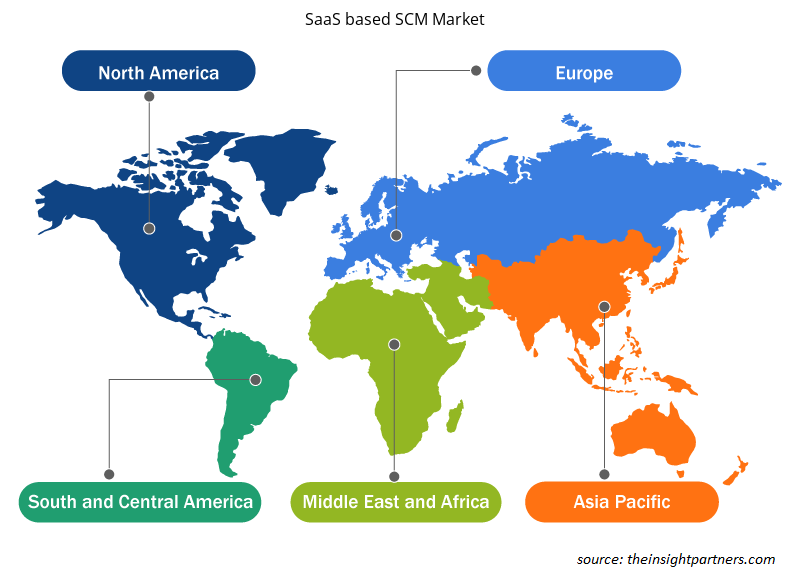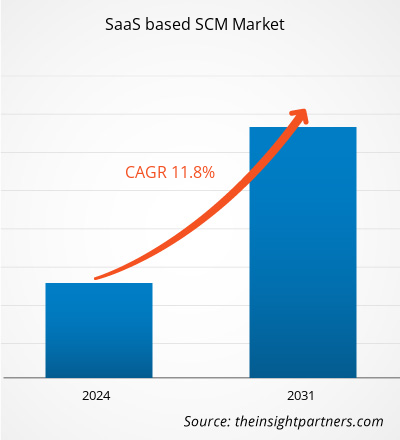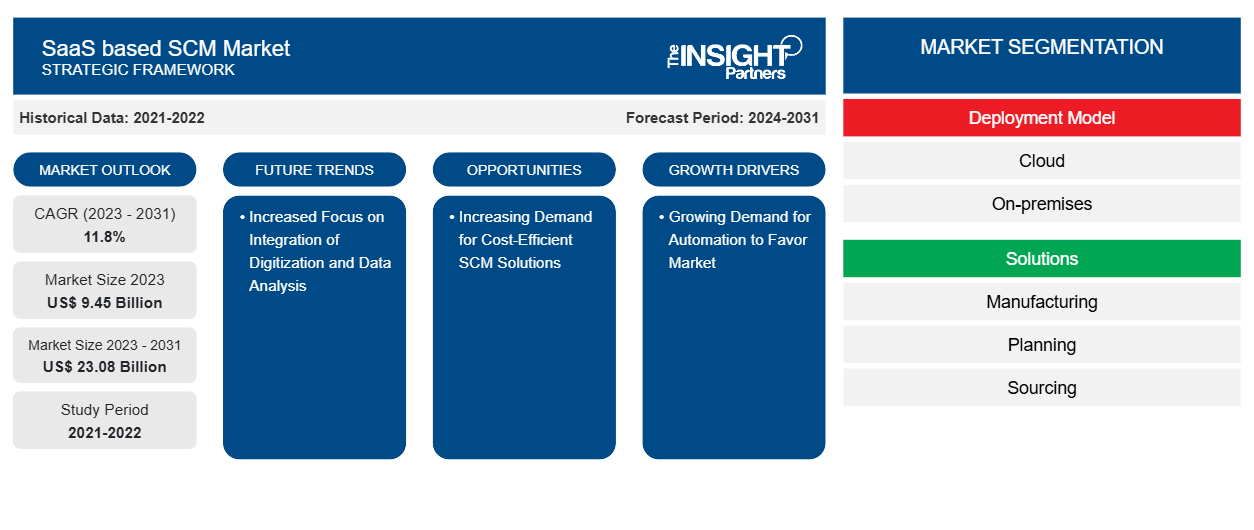基于 SaaS 的 SCM市场规模预计将从 2023 年的 94.5 亿美元增至 2031 年的 230.8 亿美元。预计 2023-2031 年市场复合年增长率将达到11.8 %。SCM 自动化需求的不断增长以及供应链可视性需求的不断增长正变得越来越重要。
基于SaaS的SCM市场分析
预计基于 SaaS 的SCM市场将快速增长,这是由于技术进步、对高效且具有成本效益的SCM解决方案的需求不断增长、对云服务的需求不断增长,同时也由于中小企业数量的增长和对集成SCM解决方案的需求,以实现供应链可视性、增强客户服务并降低成本。
基于SaaS的SCM市场概况
SaaS(软件即服务)供应链管理 ( SCM ) 软件是一种基于云的软件解决方案,可帮助企业管理整个供应链。与传统方法相比,SaaS SCM软件易于使用、可扩展且价格合理,因此被视为各种规模企业的热门选择。
定制此报告以满足您的需求
您可以免费定制任何报告,包括本报告的部分内容、国家级分析、Excel 数据包,以及为初创企业和大学提供优惠和折扣
-
获取此报告的关键市场趋势。这个免费样品将包括数据分析,从市场趋势到估计和预测。
基于 SaaS 的 SCM市场驱动因素和机遇
自动化需求不断增长,市场受益
由于自动化可以减少手工工作并提高效率,因此它在供应链管理( SCM ) 行业中越来越受欢迎。组织可以通过自动化降低费用并提高准确性来最大化其运营。此外,自动化使供应链流程能够灵活且可扩展地管理,从而帮助企业迅速适应不断变化的市场条件和客户期望。
对成本效益型SCM解决方案的需求日益增加
预计在预测期内,对集成供应链管理解决方案的需求不断增长将推动基于 SaaS 的 SCM市场的增长。市场的主要驱动力是对经济实惠、灵活且有效的供应链管理系统的需求不断增长。推动市场扩张的另一个重要方面是对经济实惠的供应链管理系统的需求不断增长。市场的另一个关键驱动力是对集成的完整供应链管理解决方案的需求不断增长。市场还受到对基于云的技术和服务日益增长的需求的推动,这些技术和服务预计将降低供应链管理成本并促进更有效的运营。
基于SaaS的SCM市场报告细分分析
有助于得出基于 SaaS 的SCM市场分析的关键部分是部署模型、解决方案、垂直行业和最终用户。
- 根据部署模型,基于 SaaS 的SCM市场分为云、本地。
- 根据解决方案,市场分为制造和规划、采购和采购、供应链规划、仓库管理、运输管理等。
- 基于垂直行业,基于SaaS的SCM市场分为运输和物流服务、制造业、零售业、公共部门和分销网络。
- 从最终用户来看,市场分为中小型企业和大型企业。
基于 SaaS 的SCM市场份额按地区分析
基于 SaaS 的 SCM 市场报告的地理范围主要分为五个区域:北美、亚太地区、欧洲、中东和非洲以及南美/南美和中美洲。北美在基于 SaaS 的 SCM 市场中占据主导地位。北美地区各行业的高科技采用趋势推动了基于 SaaS 的 SCM 市场的增长。数字技术采用率的提高和政府机构在技术方面的高投入等因素预计将推动北美基于 SaaS 的 SCM 市场的增长。此外,美国和加拿大等发达经济体高度重视研发,这迫使北美参与者将技术先进的解决方案引入市场。此外,美国拥有大量基于 SaaS 的 SCM 市场参与者,他们越来越专注于开发创新解决方案。所有这些因素都促进了该地区基于 SaaS 的 SCM 市场的增长。
基于 SaaS 的 SCM 市场区域洞察
Insight Partners 的分析师已详细解释了预测期内影响基于 SaaS 的 SCM 市场的区域趋势和因素。本节还讨论了北美、欧洲、亚太地区、中东和非洲以及南美和中美洲的基于 SaaS 的 SCM 市场细分和地理位置。

- 获取基于 SaaS 的 SCM 市场的区域特定数据
基于 SaaS 的 SCM 市场报告范围
| 报告属性 | 细节 |
|---|---|
| 2023 年的市场规模 | 94.5亿美元 |
| 2031 年市场规模 | 230.8亿美元 |
| 全球复合年增长率(2023 - 2031) | 11.8% |
| 史料 | 2021-2022 |
| 预测期 | 2024-2031 |
| 涵盖的领域 |
按部署模型
|
| 覆盖地区和国家 |
北美
|
| 市场领导者和主要公司简介 |
|
基于 SaaS 的 SCM 市场参与者密度:了解其对业务动态的影响
基于 SaaS 的 SCM 市场正在快速增长,这得益于最终用户需求的不断增长,这些需求源于消费者偏好的不断变化、技术进步以及对产品优势的认识不断提高等因素。随着需求的增加,企业正在扩大其产品范围,进行创新以满足消费者需求,并利用新兴趋势,从而进一步推动市场增长。
市场参与者密度是指在特定市场或行业内运营的企业或公司的分布情况。它表明在给定市场空间中,相对于其规模或总市场价值,有多少竞争对手(市场参与者)存在。
在基于 SaaS 的 SCM 市场运营的主要公司有:
- 笛卡尔系统集团公司
- 信息技术
- 克莱奥
- 树液
- Epicor 软件公司
- 甲骨文
免责声明:上面列出的公司没有按照任何特定顺序排列。

- 获取基于 SaaS 的 SCM 市场顶级关键参与者概述
基于 SaaS 的 SCM 市场新闻和最新发展
基于 SaaS 的 SCM 市场通过收集一手和二手研究后的定性和定量数据进行评估,其中包括重要的公司出版物、协会数据和数据库。以下是市场发展情况的列表:
- 2023 年 4 月 - 领先的面向供应链组织的 AI 驱动 SaaS 解决方案 Inspectorio 推出了 Inspectorio CAPA 推荐器,继续打破供应链行业的障碍,这是世界上第一个由 ChatGPT 驱动的生成 AI 工具,可协助品牌、零售商、供应商、工厂和其他人员进行供应链管理。
(来源:Inspectorio,新闻稿,2023 年)
- 2023 年 2 月,云安全领域的领导者之一 Zscaler, Inc. 宣布有意收购 SaaS 应用程序安全平台创新者 Canonic Security。Canonic 的平台旨在防止组织日益增加的 SaaS 供应链攻击风险。随着大规模迁移到云,随着组织采用数百个 SaaS 平台,其用户在未经 IT 许可的情况下将数千个第三方应用程序和浏览器扩展连接到其关键的 SaaS 平台,如 Atlassian Suite、Microsoft 365、Salesforce、Google Workspace 和 Slack。
(来源:Zscaler, Inc.,新闻稿,2023 年)
基于 SaaS 的 SCM 市场报告覆盖范围和交付成果
“基于 SaaS 的 SCM 市场规模和预测(2021-2031 年)”报告对以下领域进行了详细的市场分析:
- 范围内所有主要细分市场的全球、区域和国家层面的市场规模和预测
- 市场动态,如驱动因素、限制因素和关键机遇
- 未来的主要趋势
- 详细的 PEST/波特五力分析和 SWOT 分析
- 全球和区域市场分析涵盖关键市场趋势、主要参与者、法规和最新市场发展
- 行业格局和竞争分析,涵盖市场集中度、热点图分析、知名参与者和最新发展
- 详细的公司简介
- 历史分析(2 年)、基准年、预测(7 年)及复合年增长率
- PEST和SWOT分析
- 市场规模、价值/数量 - 全球、区域、国家
- 行业和竞争格局
- Excel 数据集
近期报告
客户评价
购买理由
- 明智的决策
- 了解市场动态
- 竞争分析
- 客户洞察
- 市场预测
- 风险规避
- 战略规划
- 投资论证
- 识别新兴市场
- 优化营销策略
- 提升运营效率
- 顺应监管趋势























 获取免费样品 - 基于SaaS的SCM市场
获取免费样品 - 基于SaaS的SCM市场